So you have this amazing idea of a startup that you think people are going to love. But will they?
9 out of 10 startups fail.
With such small odds of succeeding, the traditional approach of giving it all you’ve got and then seeing what happens seems very impractical.
That is why Eric Ries and Steve Blenck have made an attempt to lower the stakes by introducing the idea of a minimum viable product for startups (MVP).
In this article, we will explain different types of MVPs and show examples from successful businesses.
The idea of the ‘Lean Startup’ and how it can save you from failure
According to Wikipedia, MVP is a ‘product with just the core features sufficient to deploy it and no more’. But Eric says that you don’t even have to code to develop a minimum viable product for a startup. A landing page or crowdfunding campaign can also qualify as an MVP.
Regardless of the type, the main purpose of MVP is to learn at the least possible cost.
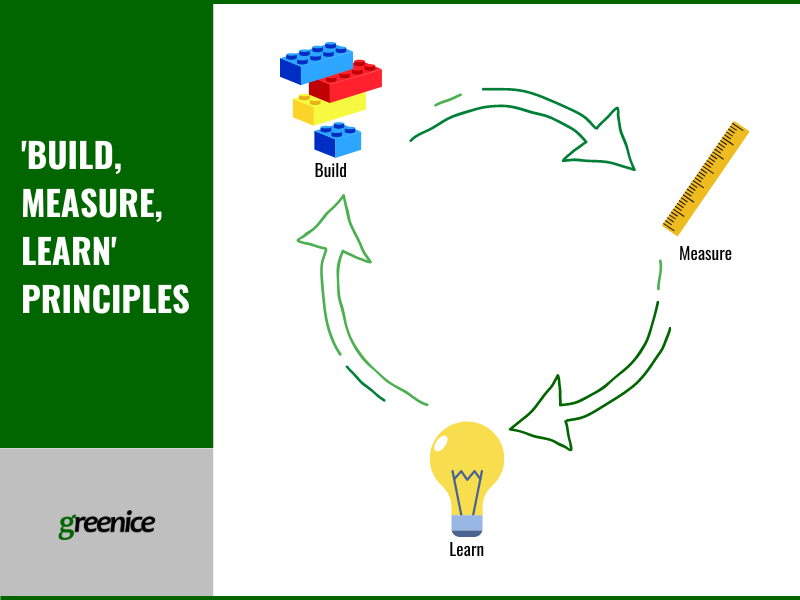
This is in contrast to the conventional idea of investing in building the perfect product and then seeing if anyone will buy it. Instead, you create a minimum viable product and run a series of small experiments and learn what people want, before building the final product.
This concept and the ‘Lean Startup’ book itself were eye-opening to me, as to someone who was taught to write old-school business plans before starting any business project. It completely changed my approach to business and marketing. In a good way, of course.
But, I’ve found that Eric doesn’t actually elaborate on the key distinctions of the different MVP types of an MVP for a technology startup and how to choose one for your startup. After all, if there are so many methods, how do you decide which one will best suit your situation?
That is why I’ve researched different types of MVPs and the purposes each of them serves. I’ve discovered that, indeed, various MVP types have very different aims. Confusing them will lead to a complete waste of your resources. Read on to learn what methods are there and how you can apply them to your business.
MVP Types
The main benefits of MVP development for a startup are the faster time to market and less time to achieve a market fit. This becomes possible with a series of MVP experiments, designed to test your idea at the earliest stages with very little investment.
There is a number of MVP ideas that you can do without coding or with as little coding as possible. That is why the MVP development cost is usually way lower than that of an end product.
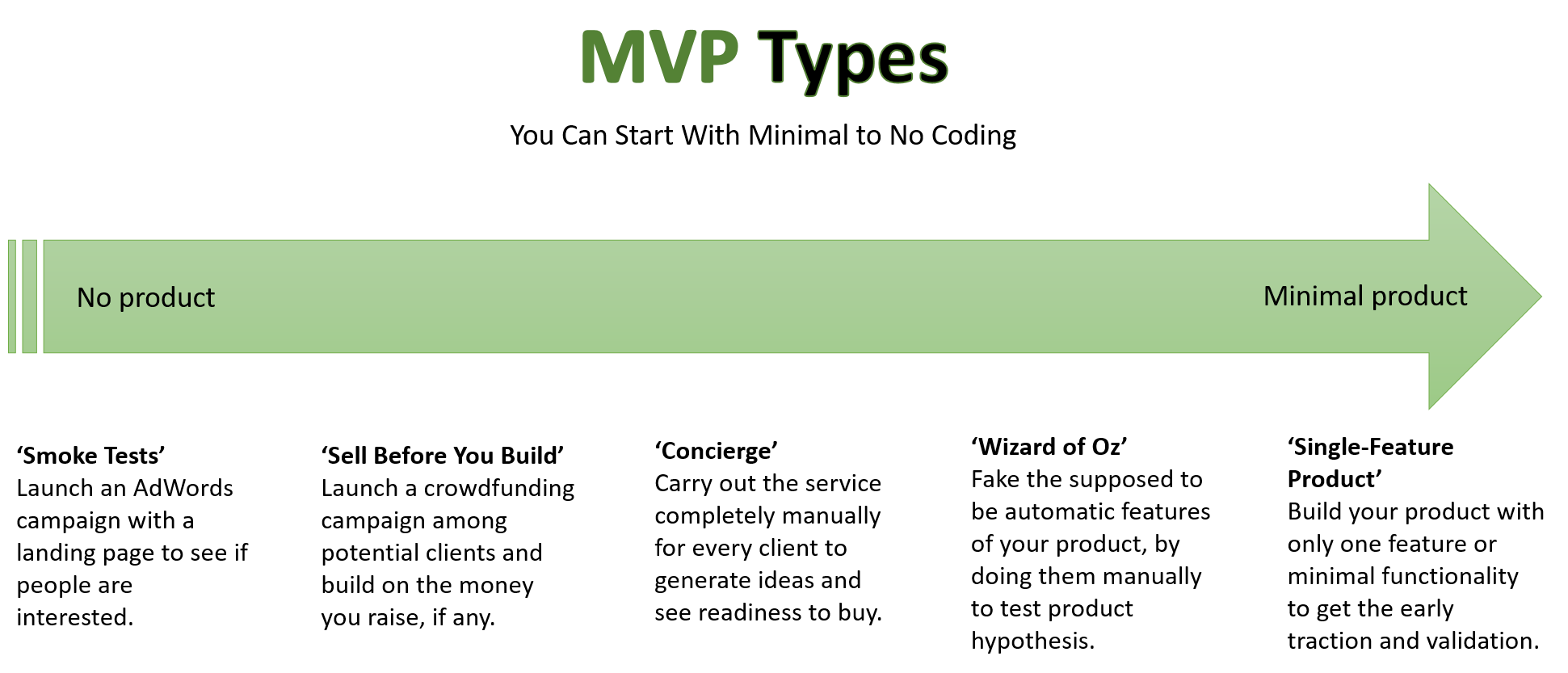
No Product MVPs
With these methods, there is no need to build an MVP app for a startup. Amazed? Here are the MVP types for that:
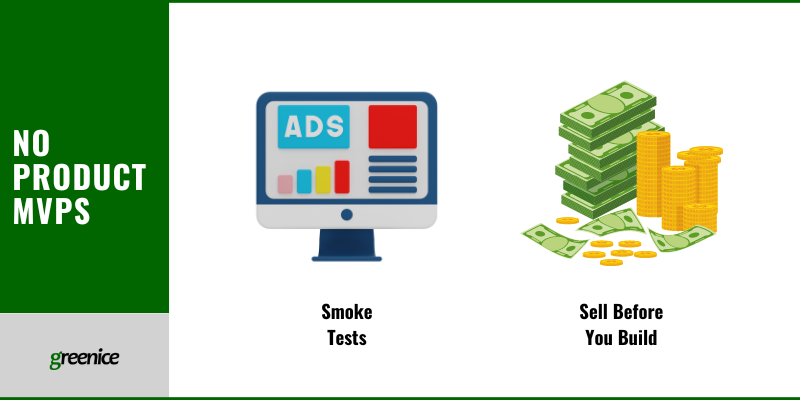
- Smoke Test
A smoke test is a method of testing a hypothesis with a marketing campaign. Eric usually speaks of setting up a landing page and running an AdWords campaign.
The landing page can contain some visuals and a description of your product or service. You can also put a cool explainer video on your landing page. Just like Dropbox founders did, when they couldn’t get their message across with just words and prototypes.
Generally speaking, this page should help your prospective customers imagine what your product will look like and suggest a simple call to action. You can offer your visitors to sign up to the waiting list, schedule a demo, or even buy your product (just to see how many will get to this step).
By the end of this experiment, you are supposed to find out if people are interested in your product or service.
And the cost to create a minimum viable product like that will equal the cost of your landing page (cost of landing page tool + your time) and your PPC campaign budget.
- Sell it, before you build it
This method implies that you have to pre-sell your product or service and build it on the money you get (if any). You can do that by launching a crowdfunding campaign on some platform like Kickstarter and try to raise money from your customers.
But the success of such a campaign will also depend on how well you can sell a product/service, that doesn’t exist yet. So you’d have to work on quality marketing materials, just like in the case with Smoke Tests.
Product Imitation MVPs
With this type of MVP, you’d have to find ways to provide the functionality of your product or service manually, with little to no technology.
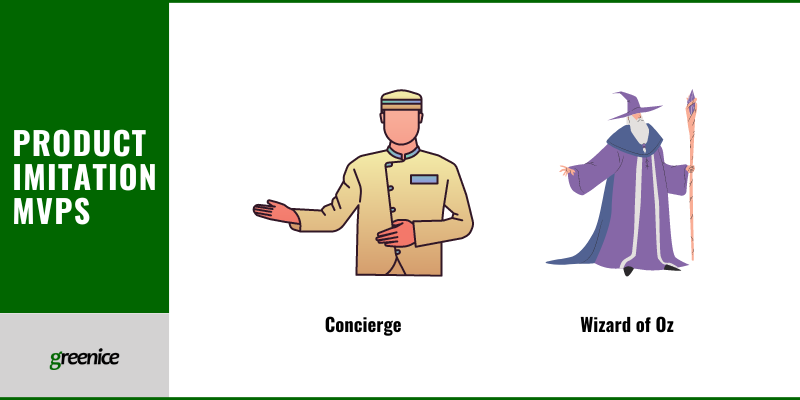
- Concierge
Concierge MVP means that you’d have to carry out all functions of your product or service individually, just like a concierge at a hotel does. You will have to work with each customer one-on-one to solve his/her problem. And in this process, you are supposed to figure out how your end product/service should look like.
For example, Food on the Table startup founders have started by making individual meal plans with their first clients and then went shopping and delivering groceries to each of them personally.
The founders were serving their customers this way up to the point they couldn’t handle the increased demand manually. Only then they got to developing the online-service and automating the processes. Now Food on the Table is a massively successful technology-driven startup.
- Wizard of Oz
‘In a Wizard of Oz test, the user experience is a complete simulation of the actual intended product, but with a slight time delay since a human cannot react as fast as a computer.’ Tristan Kromer at his Lean Startup Blog.
As Tristan states, Wizard of Oz MVP looks like an end product or service, but it isn’t. In fact, all of the functionality is also carried out by humans, just like with the Concierge method.
But in spite of this similarity, the two methods have a very important distinction. Wizard of Oz users think they are using a finished product and have no idea what happens behind the scenes (manual labor). While with Concierge, clients are getting an individual service and they know about it.
One of our clients used this method for his idea of an online factoring comparison service. He started with a simple website where clients could leave their requests for factoring services. Receiving each request, he would manually look through his database of creditors to find a match. Then he would send out individual emails to connect leads to creditors. As the number of leads grew, he hired us to build a web app that automates these processes.
Minimal Product
Then comes the actual product development. In this case, you’d have to build the first working version of your product and try to sell it to the target audience.
- Single-Feature Product
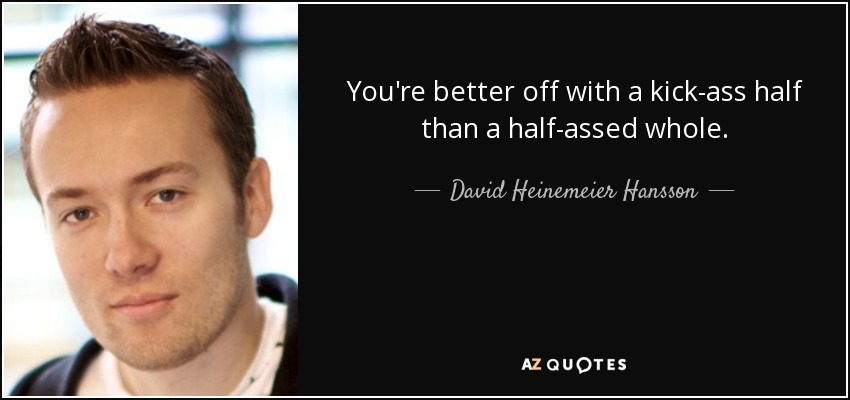
This approach is often called a Single-Feature MVP to stress the ‘Minimum’ part. To build this kind of product, you first have to figure out what should be the core functionality. What feature can solve 80% of the user’s problem with 20% of the efforts?
At this point, it is very important to understand that although you are building a ‘Single-Feature’ or a ‘few features’ product, that one or few features have to work very well.
The MVP You Choose Depends on What You Want to Learn
Now that we have listed the key MVP types, let’s see how you should choose the right type for developing an MVP for your startup app.
To do that, let’s recall what is MVP for a startup and what it represents. The main idea behind the concept is learning! Learning about potential customers and what product they will love.
So the type you choose mostly depends on what you want to learn. And on your of business, of course. Tristan Kromer, in his handbook, suggests that an MVP can serve only one of the two purposes:
- Generate ideas
- Test product hypothesis.
How do you know which one you need? This depends on the market knowledge you already have.
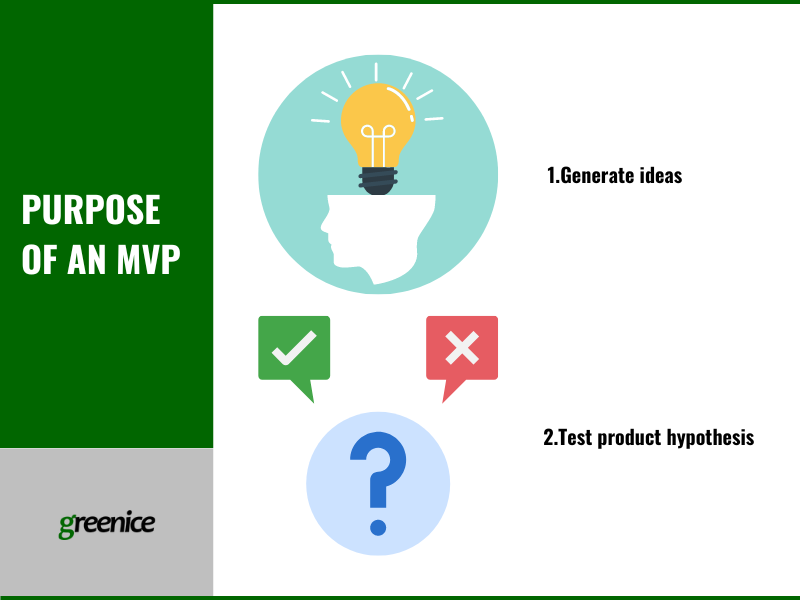
Generate Ideas
Let’s say you have a very basic idea of the market and the problem you are attempting to solve, so your idea of the product/service is very vague. In this case, you can perform qualitative market research (e.g. in-depth interviews) and/or you can run an idea-generating MVP experiment. The advantage of such an experiment is in that you will already enter into the buyer and seller relationship with your customers, not simply ask them a bunch of questions.
- Concierge
Only one of the above-mentioned methods will help you do that. I am talking about ‘Concierge’. With this method you get precious one-on-one time with clients, figuring out what they need, and finding ways to serve them.
In the example of Food on the Table, the guys started without any clear algorithm for serving their customers. But, after working with a couple of customers individually, they were able to get a better picture. They’ve translated that understanding into a product hypothesis and created the first version of their online service.
Test Hypothesis
However, if you’ve already done your homework and have a clear vision of your product/service, your next step should be to test it.
Most of the MVP methods that Eric lists are actually aimed at testing the product hypothesis.
So you can see if anyone will be interested in your VISION of the future product/service and even buy it in advance with the following methods:
- Smoke Test
- Sell Before You Build.
And when you want to know what people will think about actually USING your product, go for the following MVPs:
- Wizard of Oz
- Single-Feature Product.
You should be aware of some very important caveats of product hypothesis testing.
Minimum Viable Product Examples
Many big companies started as MVPs and developed into something bigger later. Here are just a few famous examples:
To generate a business idea
Amazon - Concierge MVP example
Today Amazon is a giant in the field of eCommerce and cloud technologies. But back then, in 1994, it was just an online book store where every task was performed manually. After users made an order, Jeff Bezos bought books in the nearest shop and sent them to the customers. His idea worked well and the assortment of goods expanded. Of course, the processes were automated later and the company moved from the garage to a normal office.
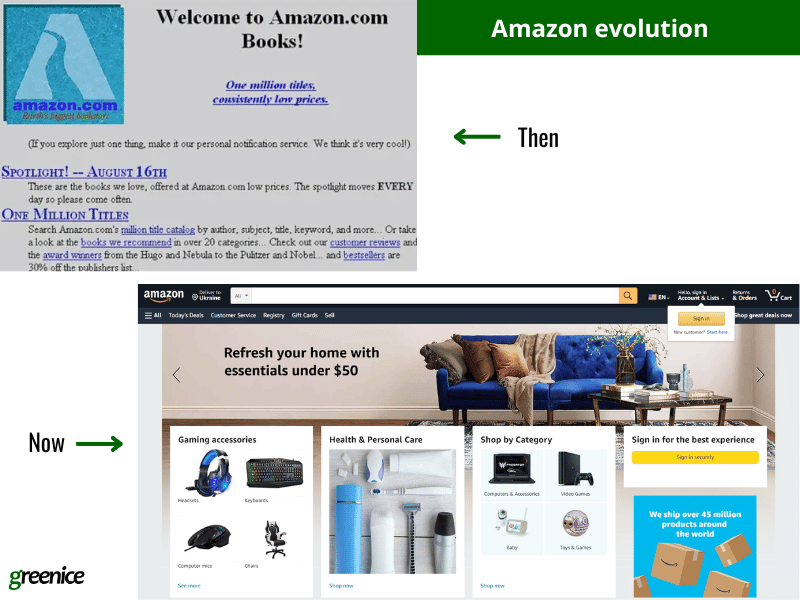
To test the hypothesis
Buffer - Smoke test MVP
The service for scheduling social media posts started as a series of landing pages. On the first page the founder Joel Gascoigne described how the product would work and asked users to fill up the signup form. Customers liked the idea and signed up for the product. The founder launched the second landing page to figure out if people would pay for the service. And still, many users reacted positively. After that, Buffer built its actual product.
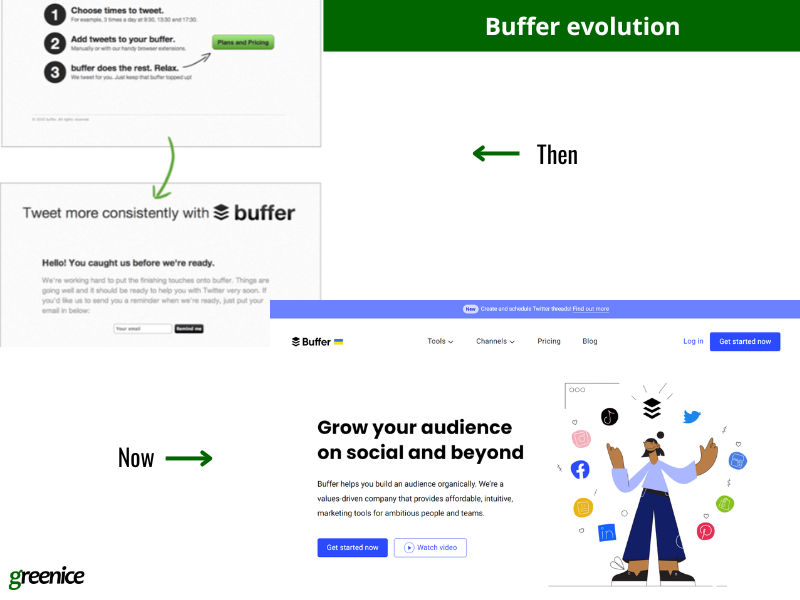
ElevationLab - ‘Sell before you build’ MVP
ElevationLab designs products to make people’s lives easier. iPhone docks, Apple stands, AirTags for pets - the company is riding the wave of practical accessories. But to turn their idea into reality they needed some funding. That’s why they used Kickstarter to raise some money and got almost 20 times more ($1,464,706) than originally planned. This allowed them to develop initial products.
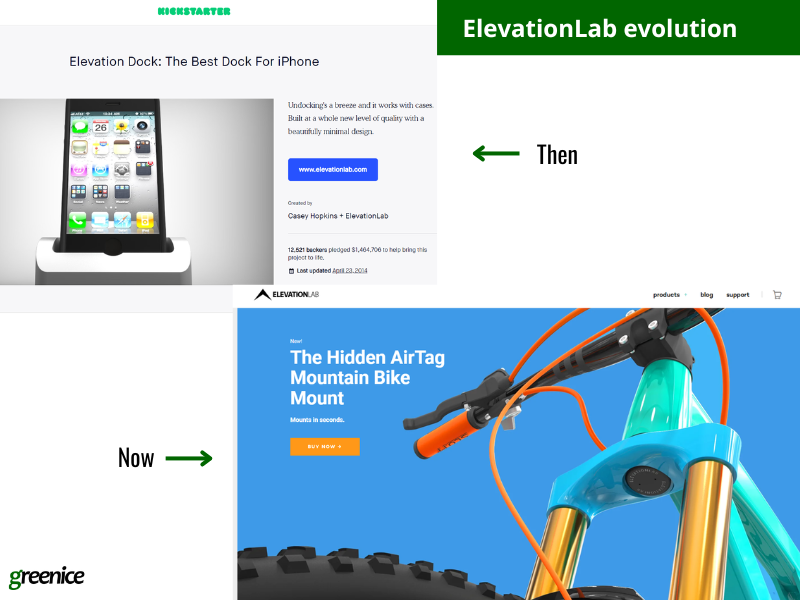
AdWords Express - Wizard of Oz MVP
AdWords Express is an advertisement service to help customers find your business on Google search. This product is an option for businesses who found Google AdWords too complicated. But when it started in 2011, it wasn’t automated at all. In reality, ad copies were written manually every time users would order the service. After the product faced great demand the founders worked on creating a complete and automated service.
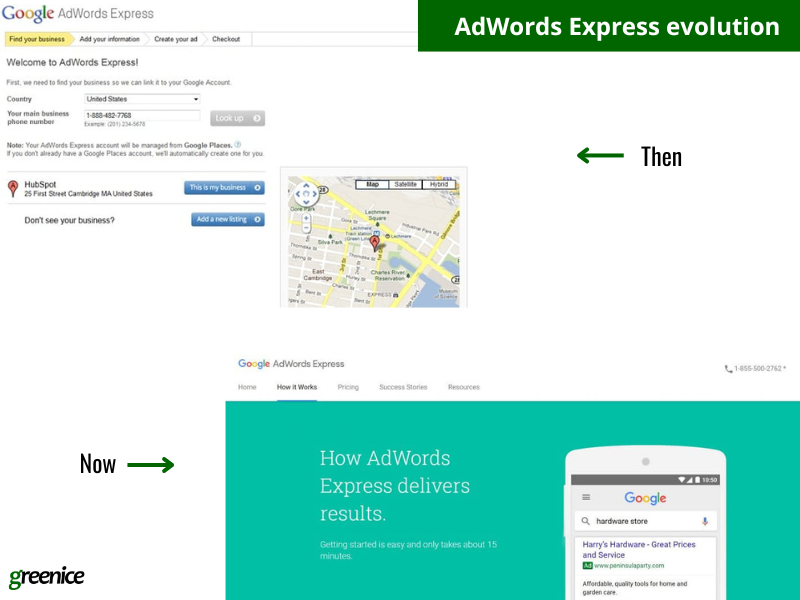
Foursquare - Single feature MVP
Today Foursquare is a giant company that specializes in location technology and app developers’ tools. But they started in 2008 as an app with a single feature. Users could share their location in real-time. Gamification of this process helped Foursquare build its client base. Later, it became possible to turn the app into a more complicated city guide.
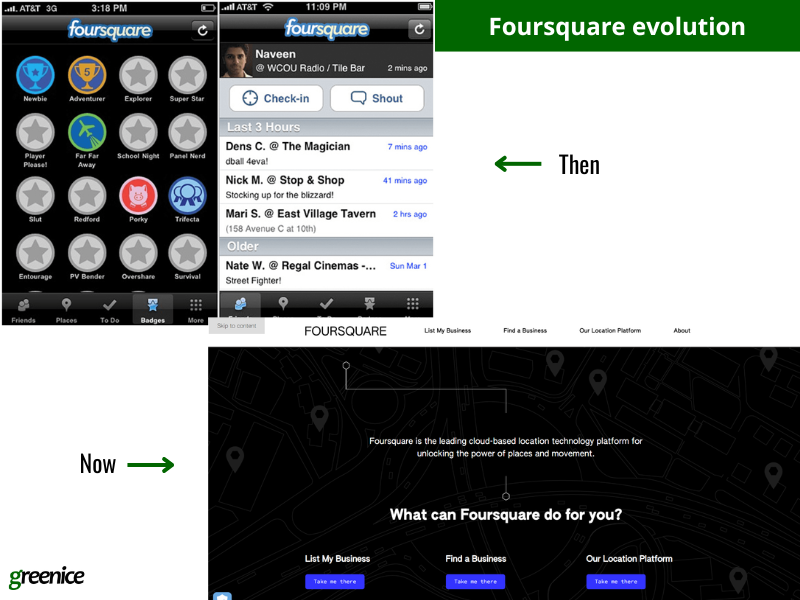
Here is a bonus example of ‘Sell before you build’ MVP and my personal favorite that shows that any idea can work.
Potato Salad
The guy set up a project on Kickstarter to raise $10 for a potato salad. A project, supported for the sake of a joke, raised $55,000. The founder was more than surprised. He decided to throw a potato salad party called “PotatoStock 2014” and later gave most of the money to charity.
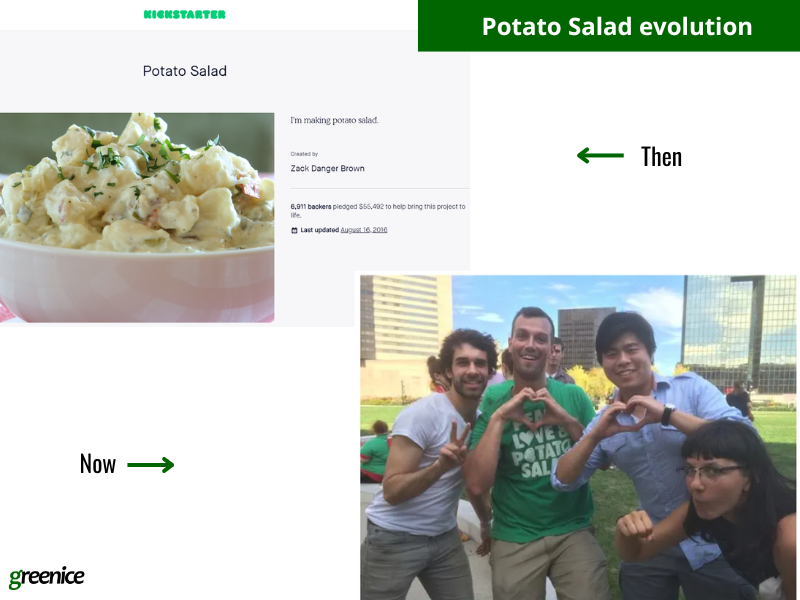
Conclusion
Let’s sum up.
There are five types of MVPs for a startup: ‘Smoke Tests’, ‘Sell Before You Build’, ‘Concierge’, ‘Wizard of Oz’, and ‘Single-Feature Product’. They vary greatly in the amount of effort you have to put in to develop one of them. Notably, for most of them, you don’t even have to code.
However, even though some methods seem to be so easy, that you feel tempted to jump right to the execution, it’s better not to. Mostly because unless you know exactly what you need to achieve (learn) with this experiment, it is bound to fail. This means that by the end of it, you will find yourself with even more questions than you had before it.
So choose your MVPs wisely!
If you decide to build an MVP app for a startup that is a ‘Single-Feature Product’ we’d glad to help you. We can help you decide on the core functionality of your product and choose the right approach to development.
Get a FREE consultation from our developers.
Contact UsRate this article!
5





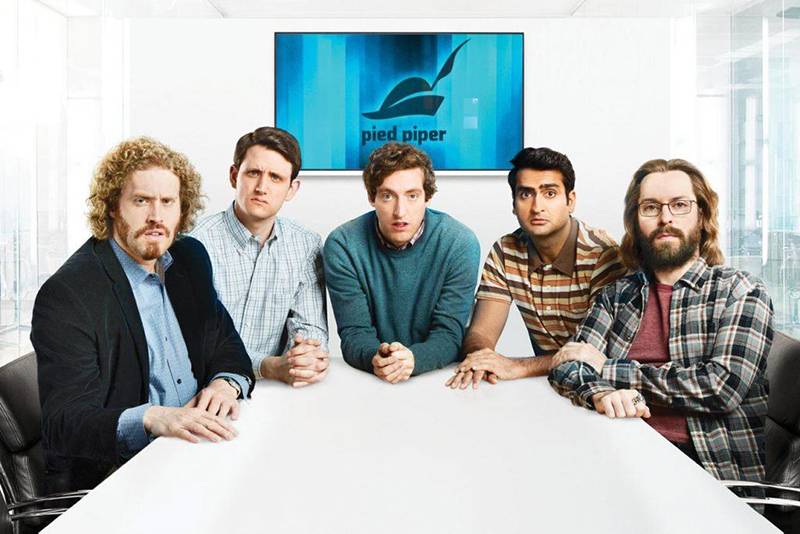

 Sign in with Google
Sign in with Google
Comments (0)